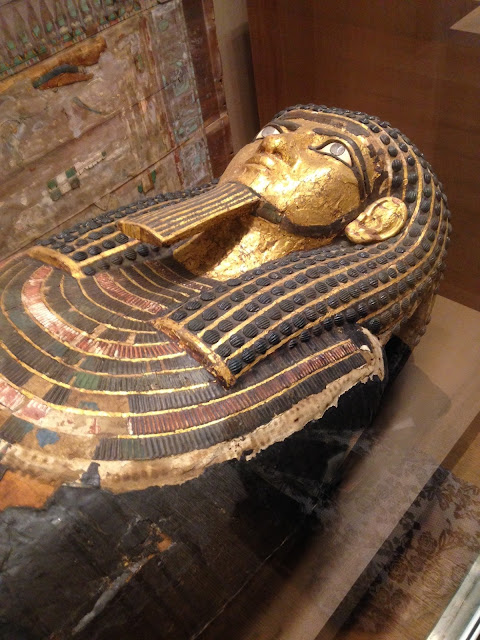Day 398 - Soul and (especially) body
February 3, 2025
The introductory wall sign in gallery 621 is captioned "Flesh and the Spirit in the Age of Rubens." The sign notes that Rubens was among many Northern Counter-Reformation artists who sought to appeal to viewers' emotions. It goes on to say that classical subjects (which I take to include religious subjects) offered what the sign describes as a "pretext," but I might term a "rationale," for sensual and even erotic images. Finally, the sign mentions the influence of Caravaggio's realism on Northern painters of the period.
The gallery holds a number of notable works by Rubens. His enormous "Wolf and Fox Hunt" occupies one entire wall; I learn that such gigantic canvases were painted to replace tapestries, a much more expensive art form, and that Rubens' assistants worked on the painting but that Rubens himself was responsible for the snarling, encircled wolves. There's also a lovely "Holy Family with Saints Francis and Anne and the Infant Saint John the Baptist" (I'm proud to have identified Saint Anne and a figure I thought looked like a Franciscan monk but didn't realize was the Franciscan monk), along with a painting of "Lot and His Daughters," which I suspect was pretty shocking in its day. Who commissioned it and where did it hang, I wonder.
The three works that are the subject of today's entry are by lesser painters than Rubens (but then, aren't almost all painters lesser artists than Rubens?) and caught my eye for various reasons. The first, "The Temptation of Saint Mary Magdalene," was completed around 1620 by Johann Liss, an artist born in Germany but active in Rome, Venice, and Amsterdam. Mary Magdalene, attired in an eye-catching white blouse, occupies the center of the composition, whose dimensions I would estimate to be 60 inches wide and 40 inches high. At the left, a turbaned figure (anti-Muslim sentiment back then?) offers her worldly goods, while at the right, an angel, whose wings are barely visible and who, to my mind, looks like a handsome young man straight out of a Caravaggio painting, takes her arm to guide her to the righteous life. But the figure who's most striking is the Magdalene herself, who, with her thrown-back head, closed eyes, and bared breasts, looks like a woman in sexual ecstasy - a Saint Theresa with exposed nipples. Presumably the painting was made for devotional purposes, but did its titillating quality add to its commercial value?
The second painting, "The Holy Family with Shepherds," painted by Jacob Jordaenes around 1616, is somewhat smaller in format (perhaps 40 inches high and 32 inches wide). It depicts the Virgin nursing, also with a bared breast, and I wonder whether viewers would have found anything lascivious in the work. But Mary's flushed cheeks and cast-down eyes bespeak maidenly modesty. At her left, Joseph holds up a candle so that the shepherds -- and we viewers -- can better see the rather pudgy holy infant. The candle illuminates an otherwise dark scene - another Caravaggio-esque touch, I think It's a sweet and tender image. I can imaginethat a devout nursing mother would have enjoyed looking at it.
I chose the last work because it illustrates the difficulty of writing descriptions of art. Painted by Michiel Sweets around 1661 and measuring roughly 48 inches wide and 30 inches high, it's entitled "Clothing the Naked," which, I learn, is one of the Seven Acts of Mercy promoted by Catholicism. Against a dark ground, it shows two figures from the waist up: a wealthy young man dressed in a silky red top and an expensive-looking fur hat, who extends a white shirt to a naked man who is slightly turned away from him. The person who wrote the description describes the latter as "seemingly wary of the garments offered to him." But just last night, I finished Arlie Russell Hochschild's book Stolen Pride, and I wondered whether the naked man's true emotion is shame as well as whether the attitude of his benefactor is censorial rather than sympathetic. Makes me question how much my response was influenced by Hochschild's book - and how good I am in reading expressions in real life.






Comments
Post a Comment